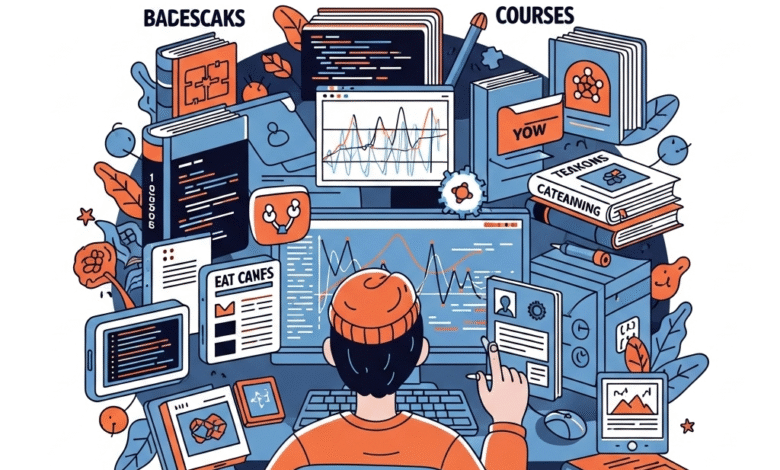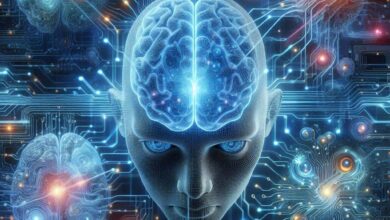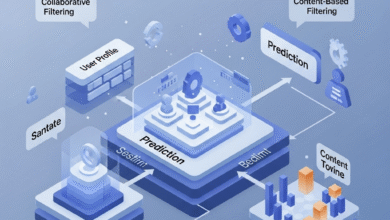Learn Machine Learning from Scratch
Your Ultimate Guide to Learn Machine Learning from Scratch (Even If You're Not a Math Whiz!)

Ditch the Doubt, Embrace the Algorithm: Your Ultimate Guide to Learn Machine Learning from Scratch (Even If You’re Not a Math Whiz!)
Hey future ML rockstar! Feeling that buzz about machine learning? You see it transforming everything from your Netflix queue to self-driving cars, and you think, “I wanna build that!” But then… the doubts creep in. “Isn’t this for PhDs?” “I barely remember high school calculus!” “Where on earth do I even START?” Take a deep breath.
Learning machine learning from scratch is absolutely possible, incredibly rewarding, and honestly, way more accessible than you think. Forget the intimidating jargon for a second. Think of it like learning to cook a fantastic new cuisine – you start with the basic ingredients and techniques, practice a lot, and gradually level up to gourmet dishes. This guide is your friendly head chef, showing you the exact path to learn machine learning from scratch, one delicious step at a time. Let’s get cooking!
Why “Learn Machine Learning from Scratch” is Your Smartest Career Move (Seriously!)
Let’s cut to the chase: machine learning isn’t just a buzzword; it’s the engine powering the future. Want proof? Check out these stats:
-
The U.S. Bureau of Labor Statistics projects much faster than average growth for computer and information research scientists (which includes ML roles) over the next decade.
-
Salaries are seriously competitive, often starting well into six figures for skilled practitioners.
-
ML skills are in demand everywhere: tech giants (Google, Amazon, Meta), finance (fraud detection, trading), healthcare (diagnostics, drug discovery), retail (recommendations, inventory), automotive (self-driving tech), and countless startups.
But beyond the paycheck and job security, learning machine learning from scratch empowers you to:
-
Solve Real-World Problems: Build systems that predict disease, optimize energy use, personalize education, or detect financial fraud.
-
Boost Your Value: Become the go-to person for data-driven insights in any field.
-
Future-Proof Your Skills: Stay relevant in a world increasingly shaped by AI and automation.
-
Unlock Creativity: ML is a toolset for building incredibly innovative products and solutions.
The best part? You don’t need a PhD to get started. You do need curiosity, persistence, and a solid roadmap – which is exactly what you’re getting here!
Busting Myths: Can You Really Learn Machine Learning from Scratch?
Let’s smash those barriers holding you back:
-
Myth 1: “I need a ton of advanced math!”
Reality: Yes, math is involved (especially linear algebra, calculus, and probability), but you don’t need to be a math professor. Focus on understanding the concepts and intuition behind the formulas. Many fantastic resources explain the math in a practical, ML-focused context. Start with the basics and learn the specific math as you need it for the algorithms you’re using. Tools like libraries (NumPy, Pandas) handle a lot of the heavy lifting. -
Myth 2: “I have to be a coding ninja!”
Reality: Python is the undisputed king of ML, and it’s known for being beginner-friendly! You need solid programming fundamentals (variables, loops, functions, basic OOP), not mastery of every obscure language feature. You’ll learn Python alongside ML concepts. -
Myth 3: “It takes years to become useful!”
Reality: You can grasp core concepts and build simple models within months of dedicated learning. The key is consistent practice and building projects. Depth comes with time and experience, but you can start applying foundational skills relatively quickly. -
Myth 4: “I need expensive hardware or a supercomputer!”
Reality: You can start learning machine learning from scratch on your everyday laptop. Cloud platforms (like Google Colab, Kaggle Notebooks) offer free access to GPUs for more intensive tasks. Expensive hardware comes much later.
The Truth: The biggest requirement is your willingness to learn, experiment, and not give up when things get tricky (which they will – that’s part of the process!).
Your Step-by-Step Blueprint to Learn Machine Learning from Scratch
Ready to dive in? Here’s your structured path, designed for absolute beginners:
Phase 1: Lay the Foundation (Gear Up!)
-
Python Proficiency (Your New Best Friend):
-
Goal: Become comfortable writing Python scripts.
-
Focus: Variables, data types (ints, floats, strings, booleans), lists, dictionaries, loops (
for,while), conditionals (if/else), functions, basic error handling (try/except), importing modules. Understand NumPy arrays and Pandas DataFrames – these are your bread and butter for handling data. -
Resources: Codecademy (Python track), freeCodeCamp (Scientific Computing with Python), Coursera (Python for Everybody – UMich), W3Schools Python Tutorial. Practice daily!
-
-
Essential Math Brush-Up (Don’t Panic!):
-
Goal: Understand the core concepts powering ML algorithms.
-
Focus:
-
Linear Algebra: Vectors, matrices, matrix multiplication, dot products. (Crucial for understanding data representation and algorithms).
-
Calculus: Derivatives (especially partial derivatives), gradients. (Crucial for understanding how algorithms learn via optimization).
-
Probability & Statistics: Basic probability rules, mean, median, standard deviation, variance, distributions (normal, binomial), hypothesis testing basics. (Crucial for understanding data, uncertainty, and model evaluation).
-
-
Resources: Khan Academy (Linear Algebra, Calculus, Statistics & Probability), 3Blue1Brown YouTube channel (amazing visual intuition), “Mathematics for Machine Learning” book/Coursera specialization (Imperial College London). Focus on intuition over complex proofs.
-
-
Command Line & Git Basics (Work Like a Pro):
-
Goal: Navigate your computer and manage code versions.
-
Focus: Basic Bash commands (
cd,ls,mkdir,pwd), installing packages (pip), using Git for version control (clone,add,commit,push,pull). Use GitHub to store your code. -
Resources: freeCodeCamp (Learn the Command Line), Atlassian Git Tutorial, GitHub’s guides.
-
Phase 2: Core Concepts & First Models (Get Your Hands Dirty!)
-
Understanding the ML Workflow:
-
Goal: Know the steps every ML project follows.
-
Focus: Problem Definition -> Data Collection -> Data Cleaning & Preprocessing -> Exploratory Data Analysis (EDA) -> Feature Engineering -> Model Selection -> Model Training -> Model Evaluation -> Model Deployment -> Monitoring. This is your roadmap.
-
-
Exploratory Data Analysis (EDA) Mastery:
-
Goal: Learn to understand and visualize your data.
-
Focus: Using Pandas for data manipulation (filtering, grouping, aggregating). Using Matplotlib and Seaborn for visualization (histograms, scatter plots, box plots, heatmaps). Identifying patterns, correlations, missing values, and outliers. EDA is where insights are born!
-
-
Your First Algorithms (The Classics!):
-
Goal: Understand, implement, and evaluate fundamental supervised learning algorithms.
-
Focus (Start Here!):
-
Linear Regression: Predicting continuous values (e.g., house prices). Understand the cost function (Mean Squared Error) and gradient descent.
-
Logistic Regression: Predicting categories (classification – e.g., spam/not spam). Understand sigmoid function and decision boundaries.
-
k-Nearest Neighbors (kNN): Simple classification and regression based on similarity.
-
-
Tools: Scikit-Learn (
scikit-learn) is your go-to library. It makes implementing these models incredibly simple. Focus onfit(),predict(), andscore()methods. -
Crucial: Model Evaluation: Learn metrics like Accuracy, Precision, Recall, F1-Score (for classification), Mean Absolute Error (MAE), Root Mean Squared Error (RMSE) (for regression). Understand the concepts of overfitting and underfitting. Learn about train/test splits.
-
Phase 3: Leveling Up & Diving Deeper (Expand Your Toolkit!)
-
More Advanced Algorithms:
-
Goal: Tackle more complex problems with powerful models.
-
Focus:
-
Decision Trees & Random Forests: Versatile and powerful for classification and regression. Understand how trees are built and why forests are better (reducing overfitting).
-
Support Vector Machines (SVMs): Effective for classification, especially with clear margins. Understand kernels.
-
Naive Bayes: Simple and fast for text classification (e.g., spam filtering).
-
Clustering (Unsupervised Learning): K-Means (grouping similar data points without predefined labels).
-
-
-
Feature Engineering Magic:
-
Goal: Transform raw data into features that make models perform better.
-
Focus: Handling missing values, encoding categorical variables (One-Hot Encoding, Label Encoding), scaling/normalizing features, creating new features (e.g., ratios, interactions), dimensionality reduction basics (PCA).
-
-
Model Evaluation & Improvement:
-
Goal: Rigorously assess models and make them better.
-
Focus: Cross-validation (k-fold), hyperparameter tuning (GridSearchCV, RandomSearchCV), learning curves, confusion matrices, ROC curves & AUC. Understanding bias-variance tradeoff deeply.
-
Phase 4: Specialization & Real-World Impact (Find Your Groove!)
-
Choose Your Path:
-
Goal: Dive deeper into areas that excite you.
-
Options:
-
Deep Learning: Neural networks, CNNs (images), RNNs/LSTMs (sequences/text), Transformers (NLP). (Libraries: TensorFlow, Keras, PyTorch).
-
Natural Language Processing (NLP): Text classification, sentiment analysis, machine translation. (Libraries: NLTK, spaCy, Hugging Face Transformers).
-
Computer Vision: Image classification, object detection, image segmentation.
-
Reinforcement Learning: Teaching agents to make decisions (e.g., game playing, robotics).
-
MLOps: Deploying, monitoring, and maintaining ML models in production.
-
-
-
Build a Killer Portfolio:
-
Goal: Showcase your skills to the world (and employers!).
-
Action: Work on diverse projects! Start simple (predict Titanic survival, classify Iris flowers), then tackle more complex problems using real-world datasets (find them on Kaggle, UCI ML Repository, Google Dataset Search). Document everything on GitHub: Clean code, READMEs explaining your process, visualizations. Blog about your learnings!
-
-
Engage with the Community:
-
Goal: Learn from others, stay motivated, find opportunities.
-
Action: Participate in Kaggle competitions (even just for learning!). Contribute to open-source ML projects (start small). Attend meetups (local or virtual). Follow experts on Twitter/LinkedIn. Ask questions (Stack Overflow, Reddit r/MachineLearning, r/LearnMachineLearning).
-
Must-Have Resources to Learn Machine Learning from Scratch (Mostly Free!)
-
Online Courses:
-
Andrew Ng’s “Machine Learning Specialization” (Coursera): The gold standard intro. Focuses on intuition and foundational math. Uses Octave/Matlab, but concepts are universal. His “Deep Learning Specialization” is the next step.
-
fast.ai (Practical Deep Learning for Coders): Top-down, code-first approach. Gets you building powerful models quickly using PyTorch. Amazing free courses.
-
Google’s Machine Learning Crash Course: Free, concise, and practical intro using TensorFlow.
-
Udacity Intro to Machine Learning with PyTorch or TensorFlow: Good structured nano-degrees.
-
-
Books:
-
“Hands-On Machine Learning with Scikit-Learn, Keras, and TensorFlow” (Aurélien Géron): The definitive practical guide. Excellent for beginners and beyond.
-
“Python Data Science Handbook” (Jake VanderPlas): Essential for mastering NumPy, Pandas, Matplotlib, and basic ML with Scikit-Learn.
-
“Pattern Recognition and Machine Learning” (Christopher Bishop): More theoretical, but a classic for deeper understanding.
-
-
Practice Platforms:
-
Kaggle: The ultimate playground. Datasets, competitions, notebooks, courses (Kaggle Learn), and a huge community.
-
Google Colab: Free Jupyter notebooks with GPU/TPU access! Perfect for running demanding models.
-
Hugging Face: Hub for NLP models and datasets. Great for exploring state-of-the-art NLP.
-
-
Communities:
-
Reddit: r/LearnMachineLearning, r/MachineLearning, r/datascience
-
Stack Overflow: For specific coding questions (search before asking!).
-
Discord Servers: Many ML communities have active Discord channels.
-
Pro Tips to Stay Sane & Successful While You Learn Machine Learning from Scratch
-
Code Every Single Day: Consistency is key, even if it’s just 30 minutes. Build the habit.
-
Focus on Understanding, Not Memorization: Grasp the why behind concepts and algorithms. How do they work? What problems do they solve? What are their strengths/weaknesses?
-
Projects, Projects, Projects! Theory is important, but applying it is where real learning happens. Start small and gradually increase complexity. Your portfolio is your proof of skill.
-
Embrace the Struggle: You will get stuck. You will encounter errors you don’t understand. This is NORMAL! Debugging is a core ML skill. Use Google, Stack Overflow, documentation, and communities. Persistence wins.
-
Don’t Try to Learn Everything at Once: The field is vast. Master the fundamentals solidly before jumping into the latest deep learning hype. A strong foundation makes everything else easier.
-
Teach What You Learn: Explaining concepts to someone else (even a rubber duck!) is the best way to solidify your understanding. Write blog posts or make short videos.
-
Find a Study Buddy/Group: Learning with others boosts motivation and helps overcome obstacles.
Your Journey Starts Now: Believe in Your Ability to Learn Machine Learning from Scratch!
The path to mastering machine learning is an adventure. It requires effort, curiosity, and resilience. But the rewards – intellectually, professionally, and creatively – are immense. You have the blueprint, the resources, and the mindset tips. The only missing ingredient is you taking that first step.
Don’t wait for the “perfect” time. Start today. Fire up a Python tutorial, revisit some high school math concepts, or browse Kaggle datasets. Every small action builds momentum. Remember, every expert was once a beginner who decided to learn machine learning from scratch.
You’ve got this! Embrace the challenge, enjoy the process of discovery, and get ready to build something amazing. The world of intelligent machines is waiting for your contribution. Now go code something!





